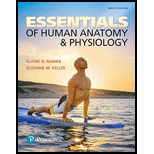
Introduction:
The building blocks of all the elements present in the universe are known as atoms, which are invisible to the naked eye. An atom, in turn, is composed of much smaller particles known as subatomic particles. The atom is divided into two main regions, including nucleus and a peripheral region. The subatomic particles, electrons, protons, and neutrons, are distributed in these two regions inside the atom.
Answer to Problem 1MC
Correct answer:
The nucleus containing the subatomic particles determines the mass of the atom. These subatomic particles determine the atomic number of the atom.
Explanation of Solution
Explanation for correct answers:
Option (a) is given that the atomic nucleus contains the atom’s mass. The nucleus contains the neutrons and protons, which hold the majority portion of the weight of the atom. The negatively charged electrons that move around the nucleus in their respective orbitals are nearly massless. Hence, option (a) is correct.
Option (c) is given that the subatomic particles can be ejected from the nucleus. Two forces work within an atom:
Option (d) is given that the atomic number is determined by the subatomic particles contained within the nucleus. The atomic number is denoted by the number of protons present within the nucleus, which is unique for each element. Hence, option (d) is correct.
Explanation for incorrect answers:
Option (b) is given that the negatively charged subatomic particles are present in the nucleus. The electrons that carry the negative charge move around the nucleus in fixed orbits. The number of protons is equal to the number of electrons present in the nucleus. So, it is an incorrect option.
Option (e) is given that the subatomic particles present within the nucleus interact with other atoms. The protons that are present within the nucleus are confined in their region and do not leave the nucleus unless there are strong nuclear forces. The electrons are mainly responsible for the interaction with other atoms by either sharing or transferring electrons. So, it is an incorrect option.
Hence, options (b) and (e) are incorrect.
Thus, the nucleus having the protons along with the neutrons makes up the mass of the atom. These subatomic particles can also be ejected from the nucleus under certain circumstances, which ultimately leads to the decay of the atom. The atomic number depends on the number of protons present within the nucleus.
Want to see more full solutions like this?
Chapter 2 Solutions
Essentials of Human Anatomy & Physiology Plus Mastering A&P with Pearson eText -- Access Card Package (12th Edition)
- Iodine has 37 known isotopes. Therefore, the atomic mass has a range of 108-144 amu. Which of the following statements concerning iodine is correct? A) The isotopes of iodine have between 55 and 91 protons. B) An atom of iodine can have between 55 and 91 neutrons. C) The isotopes of iodine will always have the same number of neutrons, but the protons can vary. D) The isotopes of iodine have between 108 and 144 neutrons, but the number of protons will not vary.arrow_forwardAtoms are incredibly tiny, so small that most microscopes can't even see them, but atoms themselves are made of even smaller particles: protons, neutrons, and electrons. Which of the following describes where protons are located in an atom? A. A shell B. The nucleus C. Both the nucleus and a shellarrow_forwardA substance formed of crystals of equal numbers of cations and anions held together by ionic bonds is called a(n) ________. a. noble gas b. salt c. electrolyte d. dipolearrow_forward
- What is a proton? A. A negatively charged particle B. A positively charged particle C. An element on the periodic table D. Any particle found in the nucleusarrow_forwardWhich of the following is a representation of a covalently bonded molecule that shows the relative size and position of atoms in three dimensions? A. Structural model B. Structural formula C. Shell model D. Chemical formulaarrow_forwardThe fundamental unit of matter, both in living and non-living matter, is thearrow_forward
- Describe the electrical charge, mass, and location of the threemajor subatomic particles in an atom?arrow_forwardSelect the best answer or answers from the choices given: The mass number of an atom is (a) equal to the number of protons it contains, (b) the sum of its protons and neutrons, (c) the sum of all of its subatomic particles, (d) the average of the mass numbers of all of its isotopes.arrow_forwardThe atomic number on an element tells us the number ofarrow_forward
- A carbon atom contains six protons and six neutrons.A. What are its atomic number and atomic weight?B. How many electrons does it have?C. How many additional electrons must it add to fill its outermost shell? How does this affect carbon’s chemical behavior?D. Carbon with an atomic weight of 14 is radioactive. How does it differ in structure from nonradioactive carbon? How does this difference affect its chemical behavior?arrow_forwardExplain why lung and soft tissue appear different on a radiograph when they have both an effective atomic number of 7.4?arrow_forwardThe atomic number gives thea. number of neutrons in the nucleus.b. number of protons in the nucleus.c. weight of the atom.d. number of protons in the valence shell.arrow_forward
 Concepts of BiologyBiologyISBN:9781938168116Author:Samantha Fowler, Rebecca Roush, James WisePublisher:OpenStax College
Concepts of BiologyBiologyISBN:9781938168116Author:Samantha Fowler, Rebecca Roush, James WisePublisher:OpenStax College Biology Today and Tomorrow without Physiology (Mi...BiologyISBN:9781305117396Author:Cecie Starr, Christine Evers, Lisa StarrPublisher:Cengage Learning
Biology Today and Tomorrow without Physiology (Mi...BiologyISBN:9781305117396Author:Cecie Starr, Christine Evers, Lisa StarrPublisher:Cengage Learning Principles Of Radiographic Imaging: An Art And A ...Health & NutritionISBN:9781337711067Author:Richard R. Carlton, Arlene M. Adler, Vesna BalacPublisher:Cengage Learning
Principles Of Radiographic Imaging: An Art And A ...Health & NutritionISBN:9781337711067Author:Richard R. Carlton, Arlene M. Adler, Vesna BalacPublisher:Cengage Learning


